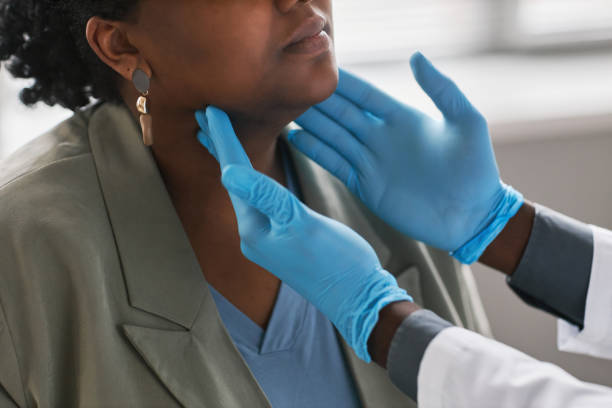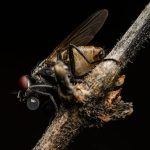If a swelling near your ear lasts for months or years, get it checked

Catherine had dismissed a slow-growing mass near her ear as a harmless pimple, for almost nine years. She had always been in good health – no diabetes, no high blood pressure in her 75 years.
But back in 2016, she noticed a small, painless bump near her right ear. It wasn’t red and didn’t itch or cause discomfort. She ignored it.
Over time, the lump grew slowly, blending into her everyday life as a minor skin issue. After all, who thinks about their parotid glands?
Things changed in February this year. The mass had grown, making chewing uncomfortable. For the first time in nine years, the lump hurt and Catherine decided to visit the hospital.
We found signs suggesting active blood flow within the mass
As a sonographer, I was part of her journey using ultrasound to assess characteristics of the well-defined hypoechoic mass – meaning a tissue area darker than the surrounding tissue – in the superficial lobe of the right parotid gland that had a diameter of 2.23 centimetres.
Through Doppler imaging, we also found signs suggesting active blood flow within the mass, and while there were no signs of aggressive invasion, there was progressive growth over nine years.
What Catherine thought was a minor skin problem turned out to be a parotid pleomorphic adenoma, a benign but persistent tumour hiding in plain sight.
Most people are familiar with major internal body organs like the heart, lungs and kidneys, but very few think about the smaller, yet crucial, organs supporting the overall smooth functioning of the body.
A case in point is the salivary glands, which people often assume are located only in the mouth. But the human body has three major pairs of salivary glands: Parotid glands, Submandibular glands and Sublingual glands.
When a tumour, infection or obstruction affects salivary glands, it can disrupt chewing, swallowing and even speech
Parotid glands, the largest of the three, are located in front of the ears and produce saliva rich in digestive enzymes. Submandibular glands are found beneath the jaw and are responsible for resting saliva production, while Sublingual glands are the smallest, located under the tongue, and produce mucus-rich saliva.
Each of these glands plays a key role in moistening food, aiding digestion and keeping the mouth healthy. When a tumour, infection or obstruction affects them, it can disrupt chewing, swallowing and even speech.
For the parotid gland, the Pleomorphic Adenoma (PA) is the most common tumour. The exact cause of Parotid Pleomorphic Adenoma (PA) is unclear, but risk factors include genetic mutations, radiation exposure and hormonal influences. Comprehensive national data on the prevalence of PA in Kenya is currently limited, necessitating the need for research initiatives on its prevalence.
However, a study conducted at the University of Nairobi Dental Hospital found that pleomorphic salivary gland adenoma was the most frequent benign tumour of the salivary glands in general, with the number of female patients being twice that of male patients. The age range of affected individuals was between eight and 68 years.
This suggests a higher occurrence in females and a wide age distribution among Kenyan patients. Urban centres like Nairobi and Mombasa report more cases due to better healthcare access and diagnostics. In contrast, rural areas may be underreported due to limited medical facilities and awareness.
Parotid glands, sit in front of the ears, quietly doing their job, until a swelling appears
PA accounts for approximately 45-75% of all salivary gland neoplasms globally. The annual incidence is estimated to be between two and 3.5 cases per 100,000 population. The parotid gland is the most affected site, with studies reporting that 67% to 84% of PAs occur in this gland. The tumour predominantly affects females, with a female-to-male ratio of about 1.5 to 1. Higher incidences were reported between the ages of 40 and 60 years.
In reality, like in Catherine’s case, the parotid glands sit just in front of the ears, quietly doing their job until a swelling appears and demands attention.
Pleomorphic adenoma is the most common benign tumor of the parotid gland. It is a slow-growing, benign tumour that arises from the cells of the parotid gland. It is called “pleomorphic” because of its varied appearance under the microscope, containing a mix of external and connective tissue elements.
While benign, these tumours don’t just stay put and continue to grow, sometimes reaching significant sizes. If left untreated for too long, they can become difficult to remove and, in rare cases, may undergo malignant transformation into an aggressive type of cancer.
To confirm Catherine’s diagnosis, a fine-needle aspiration cytology (FNAC) test was recommended by the physician before any surgical intervention was done.
Know your anatomy. Know your glands. Pay attention to persistent lumps
The FNA results confirmed a pleomorphic adenoma with no signs of malignancy. Given its continued growth and new symptoms, the best course of action was surgical removal to prevent further enlargement and potential complications. Catherine was referred to a head and neck surgeon for a parotidectomy, a surgical procedure to remove the tumour while preserving the facial nerve which runs through the parotid gland and controls facial movement.
Catherine’s story highlights a crucial but overlooked health lesson: Know your anatomy. Know your glands. Pay attention to persistent lumps.
Key to note is that not all lumps are pimples, but if a swelling near your ear lasts for months or years, get it checked. Secondly, painless growths can be significant – tumours can develop quietly before symptoms appear.
Ultrasound is a powerful tool because it is quick, non-invasive and can reveal critical insights. Early diagnosis matters because the sooner a tumour is detected, the easier it is to treat.
Catherine has now undergone a successful parotidectomy and is recovering well. Her facial nerve function was preserved, and she is expected to regain full function post-surgery.
In a nutshell, PA is a common but ‘invisible’ problem, so give it the attention it deserves.
A comprehensive approach, however, involves public education, policy changes and personal responsibility to address Parotid Pleomorphic Adenoma (PA) and other diseases of the salivary glands.
Community education on PA symptoms and early detection can encourage people to seek medical help for persistent swellings. The Ministry of Health should also integrate salivary gland screenings into routine healthcare and train providers to detect and manage these tumours. At ian ndividual level, Kenyans should prioritize regular check-ups and seek immediate medical attention for unusual jaw or neck swellings.
These tumours develop slowly and are often ignored due to their painless nature. But with awareness, early detection, and policy support, Kenya can improve PA diagnosis and overall salivary gland health.
Have you checked your parotid glands lately?
Anthony Kathendu is a Radio-Sonographer in Meru County.






















can one live a comfortable life without one parotid gland?
I believe we have the right and left
Yes, Josphine, you can live comfortably with one parotid gland. The other salivary glands compensate, so saliva production is usually fine. There might be mild dryness or slight facial changes, but nothing major. Just stay hydrated and maintain good oral care.